Atkinson K. An Introduction to Numerical Analysis
Подождите немного. Документ загружается.

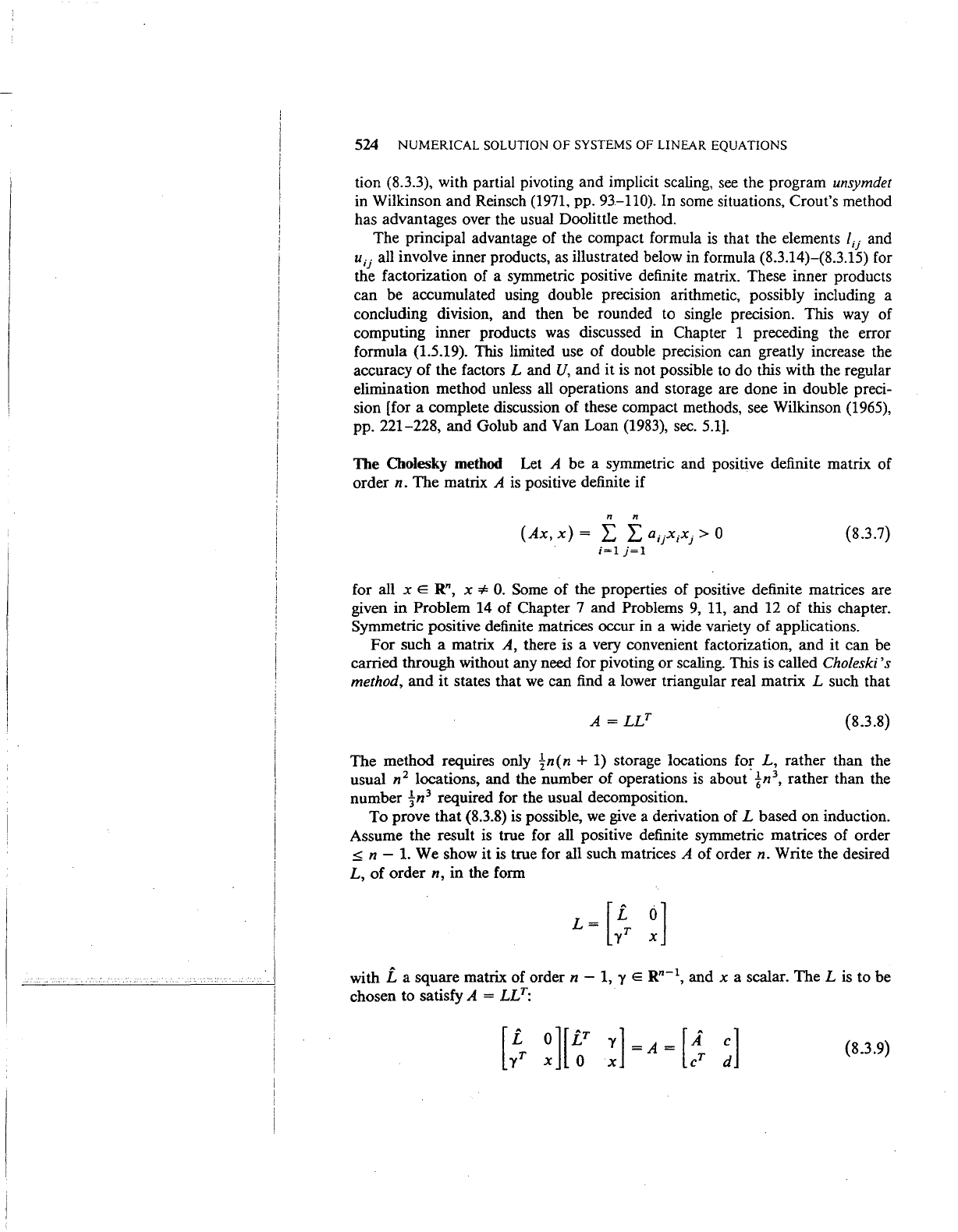
524
NUMERICAL
SOLUTION
OF
SYSTEMS
OF
LINEAR EQUATIONS
tion (8.3.3), with partial pivoting and implicit scaling,
see
the program unsymdet
in
Wilkinson and Reinsch (1971, pp. 93-110). In some situations, Crout's method
has advantages over the usual Doolittle method.
The principal advantage of the compact formula
is
that the elements lij and
uij all involve inner products,
as
illustrated below in formula (8.3.14)-(8.3.15) for
the factorization of a symmetric positive definite matrix. These inner products
can be accumulated using double precision arithmetic, possibly including a
concluding division, and then be rounded to single precision. This way of
computing inner products
was
discussed in Chapter 1 preceding the error
formula
(1.5.19). This limited use of double precision can greatly increase the
accuracy
of
the factors L and
U,
and it
is
not possible
to
do this with the regular
elimination method unless all operations and storage are done in double preci-
sion [for a complete discussion of these compact methods, see Wilkinson
(1965),
pp. 221-228, and Golub and Van Loan (1983),
sec.
5.1].
The Cholesky method Let A be a symmetric and positive definite matrix of
order n. The matrix
A
is
positive definite if
n n
(Ax,
x)
= L L
aijxixj
> 0
i=l
j=l
(8.3.7)
for all x E
R",
x *
0.
Some of the properties of positive definite matrices are
given
in
Problem 14 of Chapter 7 and Problems
9,
11,
and 12
of
this chapter.
Symmetric positive definite matrices occur
in
a wide variety of applications.
For
such a matrix A, there is a very convenient factorization, and it can be
carried through without any need for pivoting
or
scaling. This is called Choleski
's
method, and
it
states that
we
can find a lower triangular real matrix L such that
A
=LLT
(8.3.8)
The method requires only
!n(n
+ 1) storage locations fof
L,
rather than the
usual n
2
locations, and the number of operations is about
in
3
,
rather than the
number
tn
3
required for the usual decomposition.
To prove that
(8.3.8)
is
possible,
we
give a derivation of L based
on
induction.
Assume the result is true for all positive definite symmetric matrices of order
:$
n - 1. We show
it
is
true for all such matrices A of order n. Write the desired
L,
of order n, in the form
with
i a square matrix of order
n-
1, y E an-I, and x a scalar. The L
is
to be
chosen to satisfy
A =
LLT:
[
i
xo][i
0
T
YT
Y]=A=[A
X
CT
~]
(8.3.9)
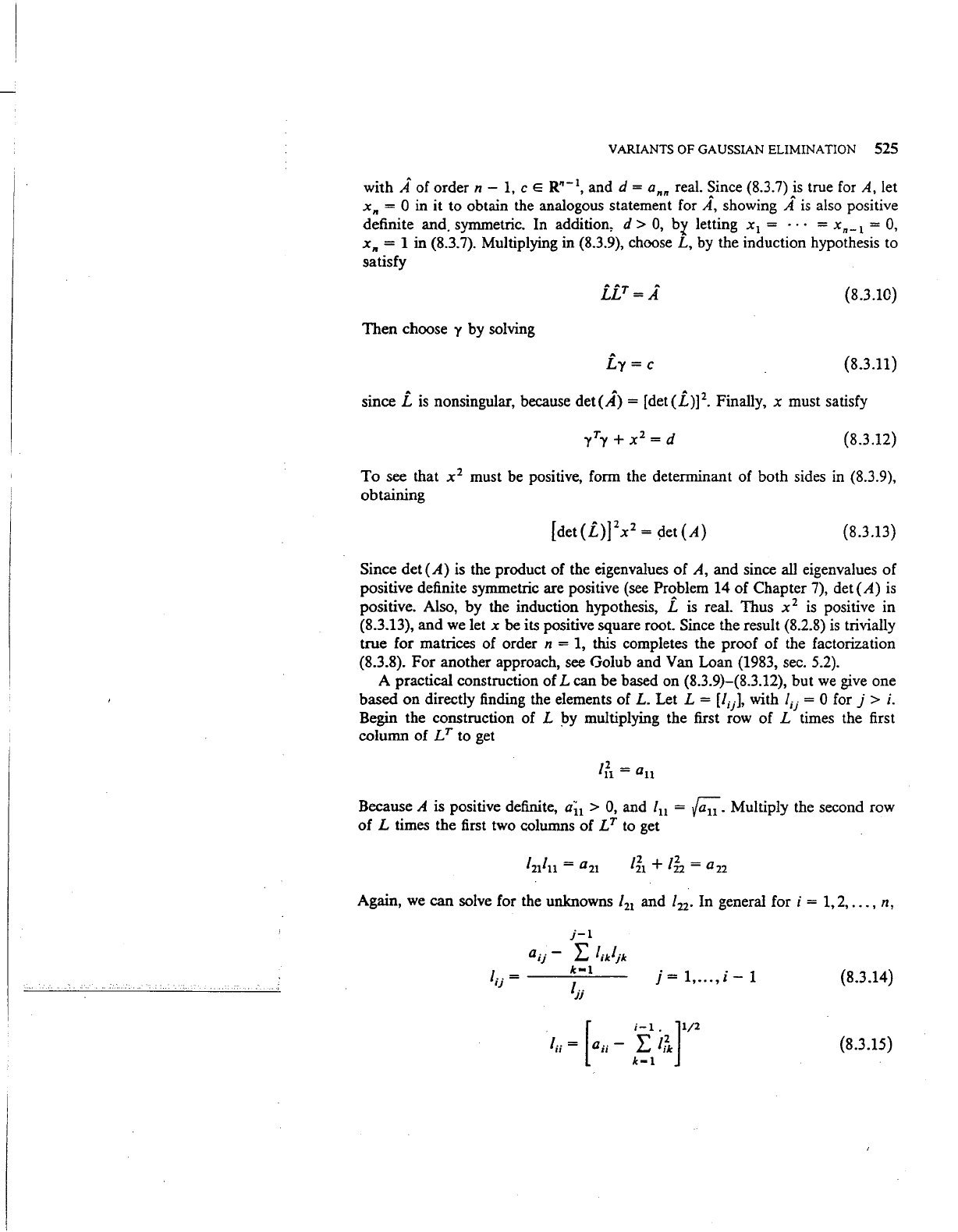
VARIANTS OF GAUSSIAN ELIMINATION
525
with A of order
n-
1,
c E R"-
1
,
and d
=a,,
real. Since (8.3.7)
is
true
for
A,
let
x,. = 0
in
it to obtain the analogous statement for
A,
showing A
is
also positive
definite and. symmetric. In addition,
d >
0,
bi' letting x
1
= · · · =
x,_
1
=
0,
x,. = 1 in (8.3.
7).
Multiplying in (8.3.9), choose
L,
by
the induction hypothesis to
satisfy
(8.3.10)
Then choose y by solving
iy
= c (8.3.11)
since i
is
nonsingular, because
det(A)
=
[det(i)]
2
•
Finally, x must satisfy
(8.3.12)
To
see that x
2
must be positive, form the determinant of both sides
in
(8.3.9),
obtaining
(8.3.13)
Since
det(A)
is the product of the eigenvalues of A, and since all eigenvalues of
positive definite symmetric are positive
(see
Problem
14
of Chapter
7),
det(A)
is
positive. Also, by the induction hypothesis, i
is
real. Thus x
2
is
positive in
(8.3.13), and
we
let x
be
its positive square root. Since the result (8.2.8)
is
trivially
true for matrices of order
n = 1, this completes the proof of the factorization
(8.3.8). For another approach, see Golub and Van Loan (1983,
sec.
5.2).
A practical construction of L can be based on (8.3.9)-(8.3.12), but
we
give
one
based
on
directly finding the elements of
L.
Let L = [/;j], with
lij
= 0 for j > i.
Begin the construction of L
by
multiplying the first row of L times the first
column of
Lr
to get
Because
A is positive definite,
a1
1
>
0,
and /
11
= {i;;. Multiply the second row
of
L times the first two columns of L T
to
get
Again,
we
can solve for the unknowns /
21
and /
22
•
In general for i = 1,
2,
...
, n,
j=1,
...
,i-1
[
i-1.
]1/2
I;;
= a;; -
1:
/~
k-1
(8.3.14)
(8.3.15)
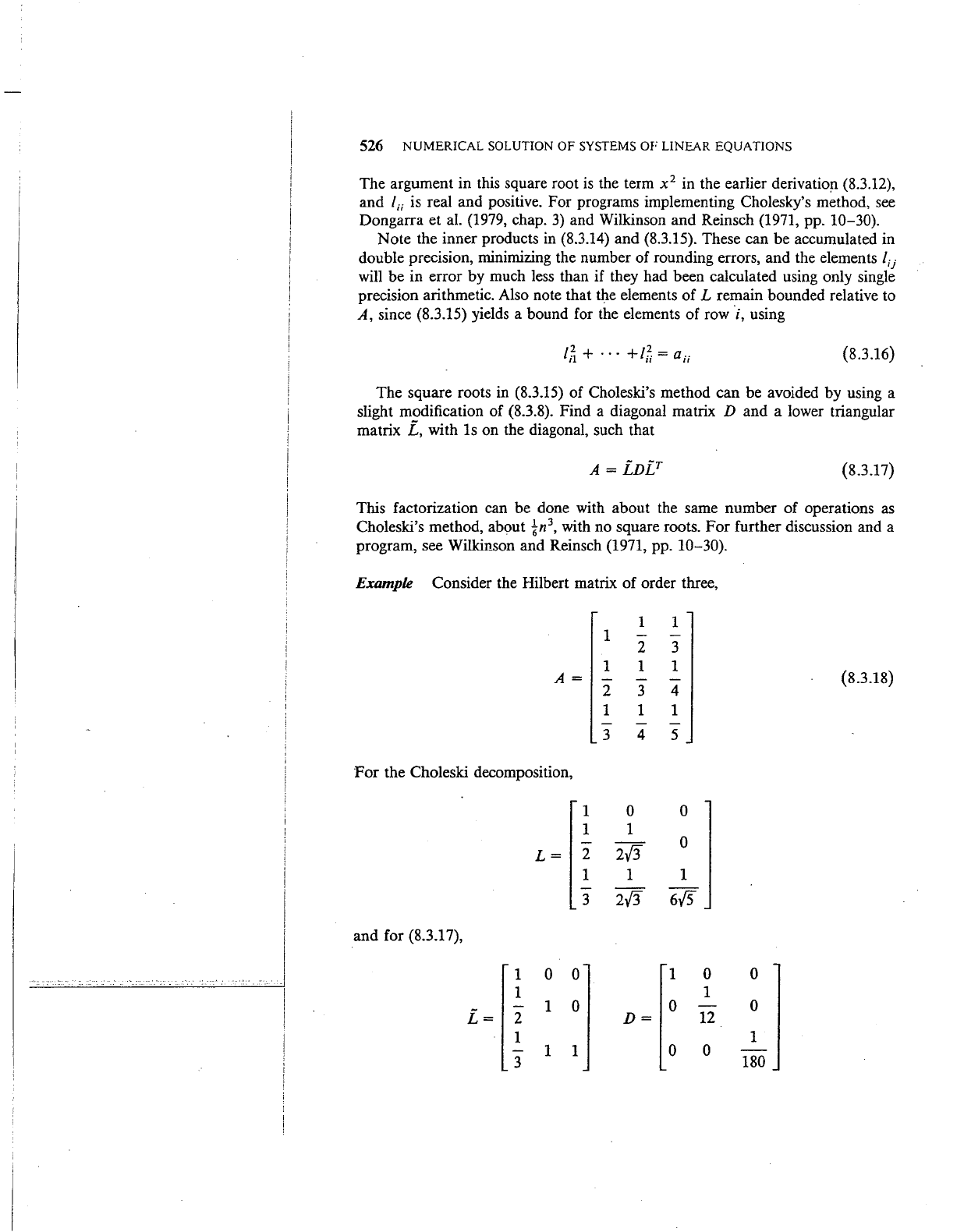
526
NUMERICAL
SOLUTION
OF
SYSTEMS OF LINEAR EQUATIONS
The argument in this square root
is
the term x
2
in the earlier derivatiop (8.3.12),
and
(;
is real and positive. For programs implementing Cholesky's method,
see
Dongarra et al.
(1979,
chap.
3)
and Wilkinson and Reinsch (1971, pp. 10-30).
Note the inner products
in
(8.3.14) and (8.3.15). These can be accumulated in
double precision, minimizing the number of rounding errors, and the elements
lij
will
be in error by much
less
than if they had been calculated using only single
precision arithmetic. Also note that the elements of
L remain bounded relative to
A, since (8.3.15) yields a bound for the elements of row ·i, using
lA
+ · · ·
+It=
au
(8.3.16)
The square roots
in
(8.3.15) of Choleski's method can be avoided by using a
slight modification of (8.3.8). Find a diagonal matrix
D and a lower triangular
matrix
L,
with
Is
on the diagonal, such that
A=
LDLT
(8.3.17)
This factorization can be done with about the same number of operations
as
Choleski's method, about
tn
3
,
with no square roots.
For
further discussion and a
program, see Wilkinson and Reinsch (1971, pp.
10-30).
Example Consider the Hilbert matrix of order three,
1
1
1
- -
2 3
1 1 1
A=
- - -
2 3 4
(8.3.18)
1 1 1
3
4
5
For
the Choleski decomposition,
1
0
0
1 1
L=
2
2{3
0
1
1 1
3
2{3
6{5
and for (8.3.17),
1
0 0
1 0 0
1
1
L=
1 0 0
-
0
2
D=
12
1
1
1 1
0
0
-
3
180

VARIANTS OF GAUSSIAN ELIMINATION
527
For
many linear systems in applications, the coefficient matrix A is banded,
which means
if
li-
Jl
> m
(8.3.19)
for some small m >
0.
The preceding algorithms simplify
in
this case, with a
considerable savings in computation time. For such algorithms when A is
symmetric and positive definite, see the
UNPACK
programs
in
Dongarra et al.
(1979, chap. 4). We next describe an algorithm
in
the case m = 1 in (8.3.19).
Tridiagonal systems The matrix A = [a;j] is tridiagonal
if
for
li-
Jl
> 1
(8.3.20)
This gives the form
al
cl
0 0 0
b1
a2
c2
0
0
b3
aJ
c3
A=
(8.3.21)
0
Tridiagonal matrices occur
in
a variety
of
applications. Recall the linear system
(3.7.22) for spline functions
in
Section 3.7
of
Chapter
3.
In
addition, many
numerical methods for solving boundary value problems for ordinary and partial
differential equations involve the solution
of
tridiagonal systems. Virtually all
of
these applications yield tridiagonal matrices for which
the
LU
factorization can
be
formed without pivoting, and for which there is
no
large increase in error as a
consequence. The precise assumptions
on
A are given below in Theorem 8.2.
By considering the factorization A =
LU
without pivoting, we find that most
elements
of
L and U will
be
zero. And we are lead to the following general
formula for the decomposition:
A
=LU
al
0
0
1
YI
0 0
b2
a1
0
0
1
Y2
0
0
b3
.
a3
1
Yn-1
0
bn
an
0
0
1
We can multiply to obtain a way to recursively compute {a;} and {
Y;}:
i = 2,
...
, n
(8.3.22)
i = 2, 3,
...
,
n-
1
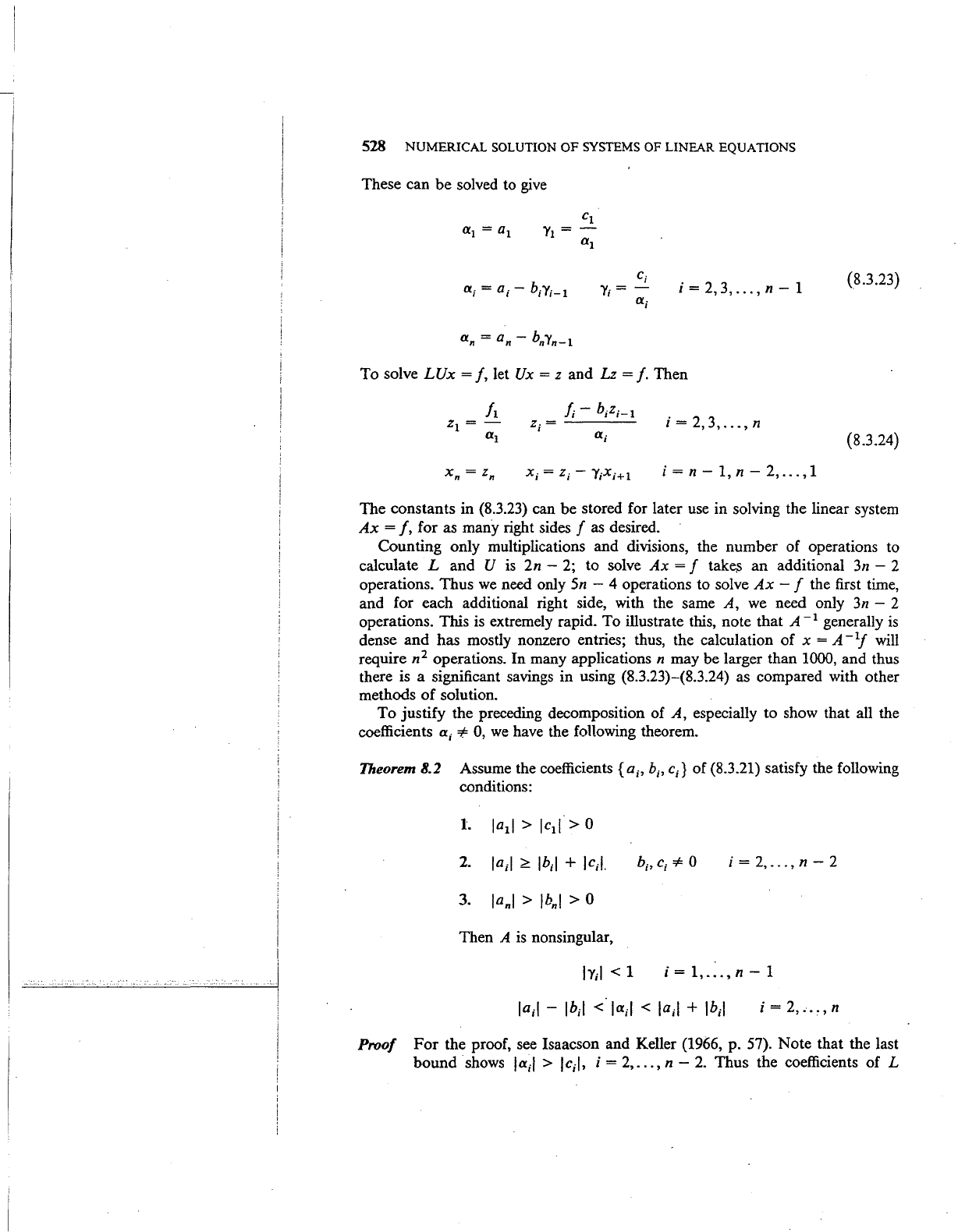
528
NUMERICAL SOLUTION
OF
SYSTEMS OF LINEAR EQUATIONS
These can be solved to
give
C;
'V.
=-
,,
a;
i = 2, 3,
...
, n - 1
To solve
LUx
= f, let Ux = z and Lz
=f.
Then
z.=
I
i = 2, 3,
...
, n
i =
n-
1,
n-
2,
...
, 1
(8.3.23)
(8.3.24)
The constants in (8.3.23) can be stored for later
use
in solving the linear system
Ax
=
j,
for as many right sides f as desired.
Counting only multiplications and divisions, the number of operations to
calculate
L and U
is
2n -
2;
to solve
Ax
= f
take~
an additional
3n
- 2
operations. Thus
we
need only
Sn
- 4 operations to solve
Ax
- f the first time,
and for each additional right side, with the same
A,
we
need only
3n-
2
operations. This
is
extremely rapid. To illustrate this, note that A
-I
generally
is
dense
and
has mostly nonzero entries; thus, the calculation of x =
A-
Y will
require
n
2
operations. In many applications n may be larger than 1000, and thus
there is a significant savings in using (8.3.23)-(8.3.24) as compared with other
methods
of
solution.
To justify the preceding decomposition of
A,
especially to show that all the
coefficients
a;
=I'
0,
we
have the following theorem.
Theorem 8.2 Assume the coefficients {a;,
b;,
C;}
of (8.3.21) satisfy the following
conditions:
2.
la;l
~
lb;l
+
lc;l.
i=2,
...
,n-2
3.
lanl
>
lbnl
> 0
Then A
is
nonsingular,
i=l,
...
,n-1
i = 2,
..
, n
Proof
For
the proof, see Isaacson and Keller (1966, p. 57). Note that the last
bound shows
la;l
>
lc;l,
i =
2,
...
,
n-
2.
Thus the coefficients of L
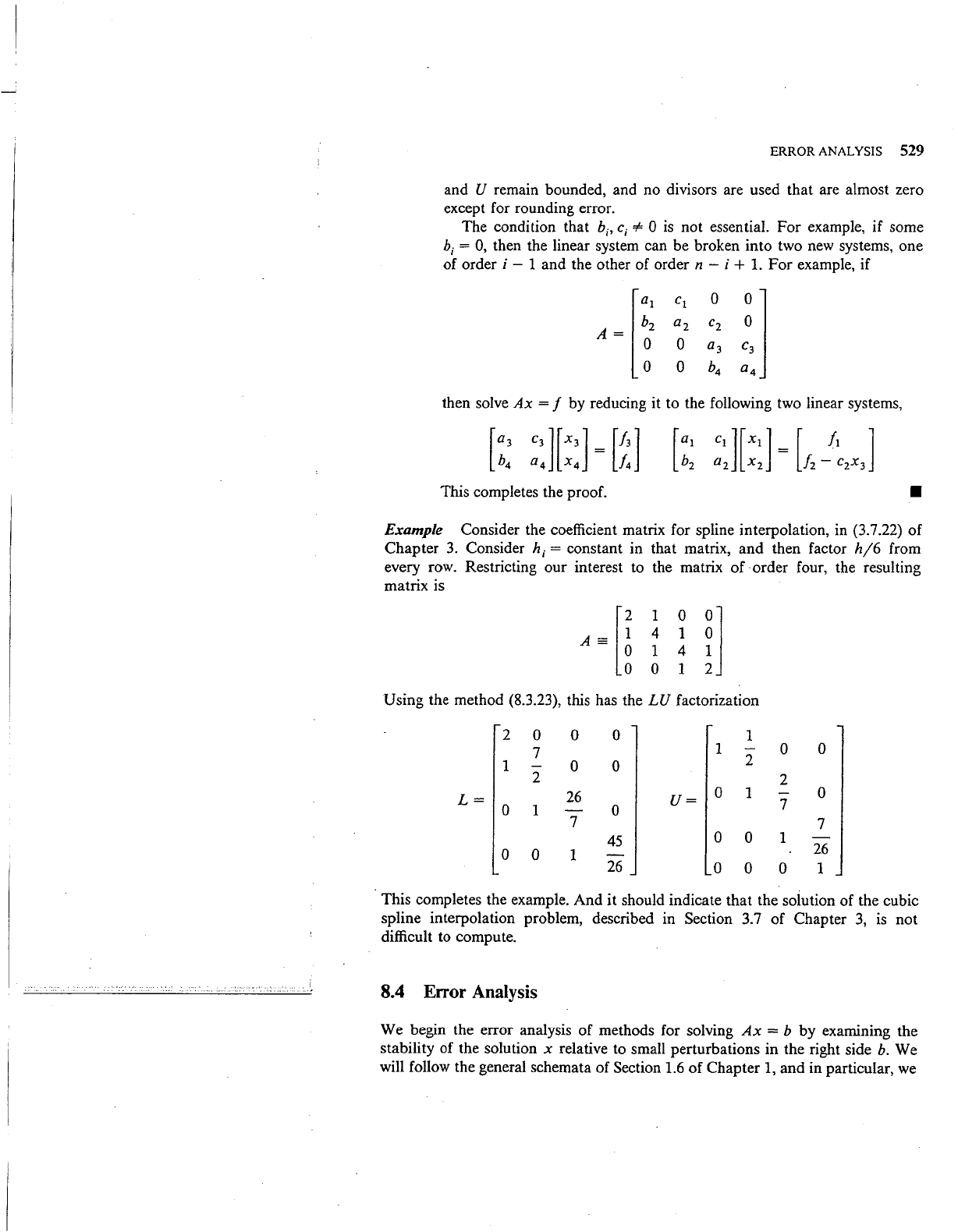
ERROR
ANALYSIS 529
and
U remain bounded, and
no
divisors are used
that
are almost zero
except for rounding error.
The condition that
h;.
c;
* 0
is
not essential.
For
example, if some
h;
= 0, then the linear system can be broken
into
two new systems,
one
of
order i - 1
and
the other of order n - i + 1.
For
example, if
then solve
Ax
= f
by
reducing it
to
the following two linear systems,
[
a3
c3][x3]
[/3]
[al
c1][x1]
[
/1
]
b4
°4
X4
=
!4
b2
°2
X2
=
!2-
C2X3
This completes the proof.
•
Example Consider the coefficient matrix for spline interpolation, in (3.7.22)
of
Chapter
3.
Consider h; = constant in that matrix,
and
then factor
hj6
from
every row. Restricting
our
interest to the matrix
of
order
four, the resulting
matrix is
A=
l~
1
0
[]
4 1
1 4
0 1
Using
the method (8.3.23), this has the
LU
factorization
2
0 0 0
1
7
1
-
0
0
1
0 0
2
2
2
L=
26
U=
0 1
-
0
0
1
0
7
7
7
45
0
0
1
0 0
1 -
26
26
0
0 0
1
This completes the example.
And
it should indicate
that
the solution of the cubic
spline interpolation problem, described in Section 3.7
of
Chapter
3,
is
not
difficult to compute.
8.4
Error
Analysis
We begin the error analysis
of
methods for solving
Ax
= b
by
examining the
stability of the solution
x relative to small perturbations
in
the right side
b.
We
will follow the general schemata
of
Section 1.6
of
Chapter
1,
and
in particular, we
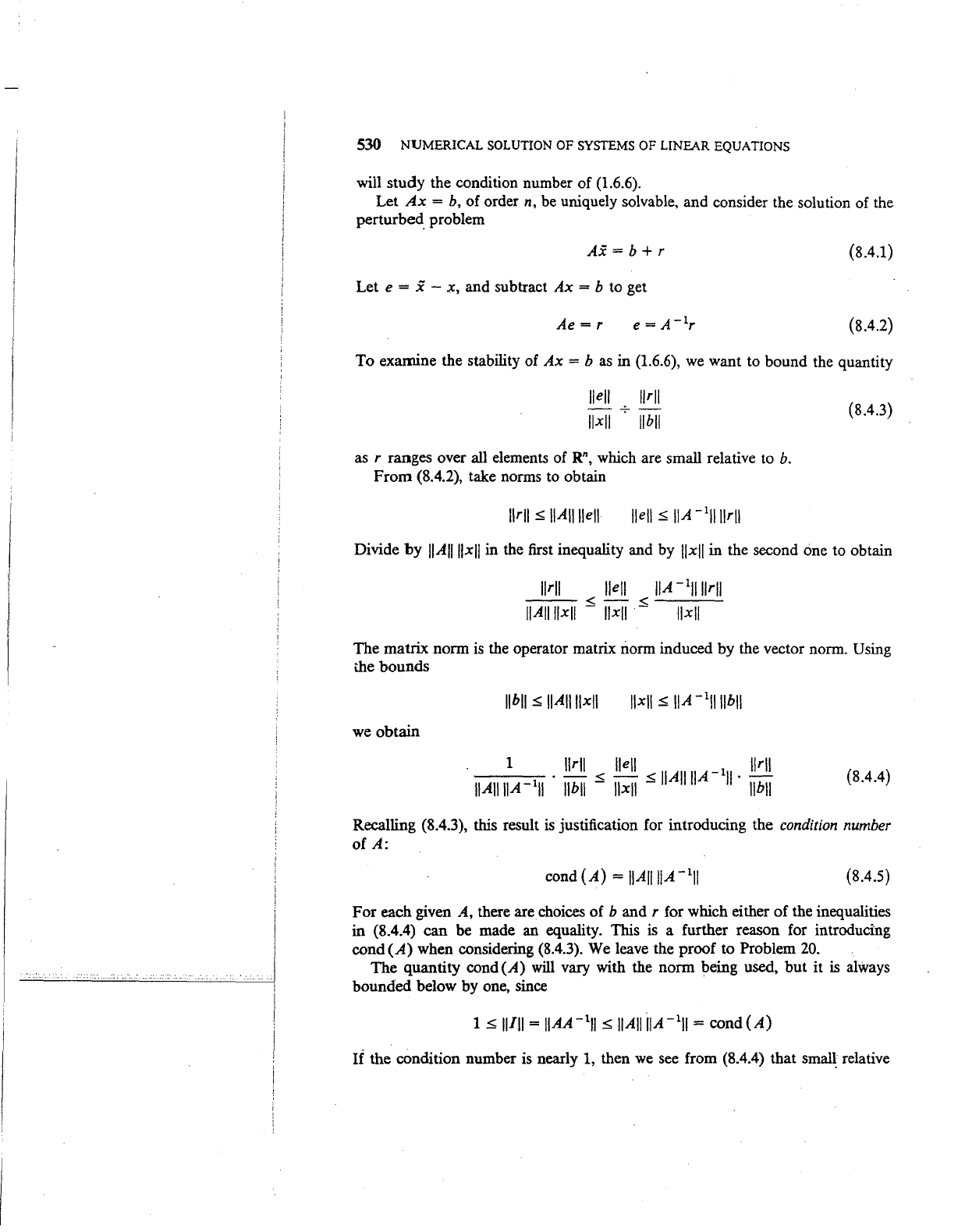
530
NUMERICAL SOLUTION OF SYSTEMS OF LINEAR EQUATIONS
will study the condition number of (1.6.6).
Let
Ax
= b, of order n, be uniquely solvable, and consider the solution of the
perturbed. problem
Ai
= b + r
(8.4.1)
Let e = i -
x,
and subtract
Ax
= b to get
Ae = r
(8.4.2)
To
examine the stability of
Ax
= b as in (1.6.6),
we
want to bound the quantity
(8.4.3)
as r ranges over all elements of
Rn,
which are small relative to
b.
From
(8.4.2), take norms to obtain
Divide
by
IIAIIIIxll
in the first inequality and by
Uxll
in the second one to obtain
Urll
llell
IIA
-
1
1lllrll
---<-
<---
IIAIIIIxll
-
llxll
-
llxll
The
matrix norm
is
the operator matrix norm induced by the vector norm. Using
tlle
bounds
we obtain
1
llrll
lieU
A A _
1
llrll
IIAIIIIA-
1
11
. jj'ij
.s
W
.s
II II II
II·
jj'ij
(8.4.4)
Recalling (8.4.3), this result
is
justification for introducing the condition number
of
A:
cond
(A)=
IIAIIIIA
-
1
11
(8.4.5)
For
each given
A,
there are choices
of
b and r for which either
of
the inequalities
in (8.4.4)
can
be made an equality. This
is
a further reason for introducing
cond(A)
when considering (8.4.3).
We
leave the proof to Problem
20.
The
quantity cond (A) will vary with the norm being used,
but
it
is
always
bounded below by one, since
If
the condition number
is
nearly 1, then
we
see from (8.4.4) that
smal~
relative

ERROR
ANALYSIS 531
perturbations
in b will lead to similarly small relative perturbations
in
the
solution
x.
But if
cond(A)
is large, then (8.4.4) suggests
that
there may
be
small
relative perturbations
of
b
that
will lead
to
large relative perturbations in x.
Because (8.4.5) will vary with the choice
of
norm, we sometimes use
another
definition
of
condition number,
one
independent
of
the
norm.
From
Theorem 7.8
of
Chapter
7,
Since the eigenvalues
of
A
-I
are the reciprocals
of
those
of
A,
we have the result
cond
(A)
:<::
=
cond
(A)*
Min
IAI
>.ea(A)
Max
!AI
>.ea(A)
in
which
a(A)
denotes the set
of
all eigenvalues
of
A.
Example Consider the linear system
For
the coefficient matrix,
A=[~
1~]
10]
-7
(8.4.6)
(8.4.7)
Let
the condition
number
in
(8.4.5)
be
denoted
by
cond
(A)
P when it is generated
using the matrix
norm
II
·
llr
For
this example,
cond
(A)
1
= cond (A)
00
= (17)(17) = 289,
cond
(A h
;;;
223
cond
(A)*
;;;
198
These condition numbers all suggest
that
(8.4.7)
may
be
sensitive to changes in
the right side
b.
To
illustrate this possibility, consider the particular case
which has the solution
For
the
perturbed
system, solve
7x
1
+
10x
2
= 1
5x
1
+ 7x
2
=
.7
x
2
=
.1

532
NUMERICAL
SOLUTION
OF
SYSTEMS
OF
LINEAR EQUATIONS
It
has the solution
.X\=-.17
The relative changes
in
x are quite large when compared with the size of the
relative changes in the right side
b.
A linear system whose solution x is unstable with respect to small relative
changes in the right side
b
is
called ill-conditioned. The preceding system (8.4.7)
is
somewhat ill-conditioned, especially if only three or four decimal digit floating-
point arithmetic
is
used
in
solving it. The condition numbers cond
(A)
and
cond
(A)*
are fairly good indicators
of
ill-conditioning. As they increase
by
a
factor
of
10, it
is
likely that one less digit of accuracy will be obtained in the
solution.
In
general, if cond (A)*
is
large; then there will be values
of
b for which the
system
Ax=
b
is
quite sensitive
to
changes r in b. Let
A.
1
and
A.u
denote
eigenvalues
of
A for which
j"A
1
1 = Min
i"AI
AEo(A),
I"Aul
= Max
I"AI
>.eo(
A)
and
thus
cond
(A)*=
I~~
I
(8.4.8)
Let
x
1
and
xu
be corresponding eigenvectors, with
llx
1
lloc
=
llxulloo
= L Then
has the solution
X =
Xu·
And the system
has the solution
If
cond
(A)*
is large, then the right-hand side has only a small relative perturba-
tion,
llrllco
1
--=
llbllco
cond
(A)*
(8.4.9)
But for the solution,
we
have the much larger relative perturbation
(8.4.10)
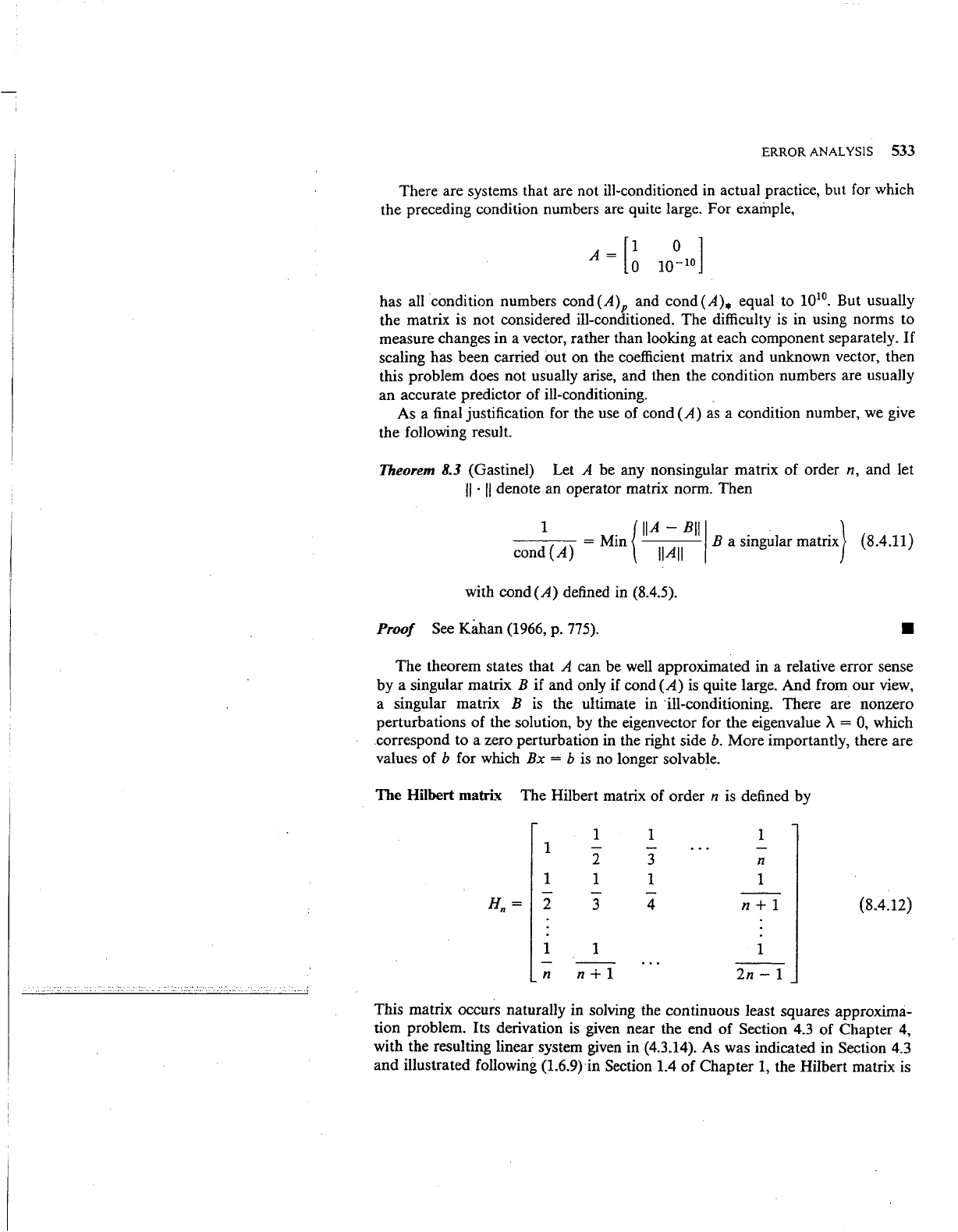
ERROR ANALYSIS 533
There are systems that are not ill-conditioned
in
actual practice, but for which
the preceding condition numbers are quite large. For example,
has all condition numbers cond(A)P and
cond(A).
equal to 10
10
•
But usually
the matrix
is
not considered ill-conditioned. The difficulty
is
in using norms to
measure changes in a vector, rather than looking at each component separately.
If
scaling has been carried out on the coefficient matrix and unknown vector, then
this problem does not usually arise, and then the condition numbers are usually
an accurate predictor of ill-conditioning.
As a final justification for the use of cond (A)
as
a condition number, we give
the following result.
Theorem 8.3 (Gastinel) Let A be any nonsingular matrix
of
order n, and let
II
·
II
denote an operator matrix norm. Then
1 {
IIA
-
Bill
. }
d (
)
= Min B a singular matrix
con
A
IIAII
(8.4.11)
with cond (A) defined in (8.4.5).
Proof
See Kahan (1966, p. 775).
•
The theorem states that A can be well approximated in a relative error sense
by a singular matrix
B if and only if
cond(A)
is
quite large. And from our view,
a singular matrix
B
is
the ultimate in ·ill-conditioning. There are nonzero
perturbations of the solution, by the eigenvector for the eigenvalue
A =
0,
which
correspond to a zero perturbation in the right side
b.
More importantly, there are
values of
b for which
Bx
= b is no longer solvable.
The Hilbert matrix
The Hilbert matrix of order n is defined by
1 1
1
1
2
3 n
1 1
1 1
-
H=
n
2
3 4
n+1
(8.4.12)
1
1
1
n
n+1
2n-
1
This matrix occurs naturally in solving the continuous least squares approxima-
tion problem. Its derivation
is
given near the end
of
Section 4.3
of
Chapter
4,
with the resulting linear system given in (4.3.14). As was indicated in Section 4.3
and illustrated following (1.6.9) in Section 1.4
of
Chapter
1,
the Hilbert matrix
is
